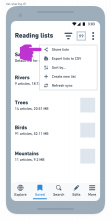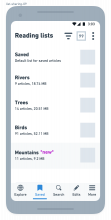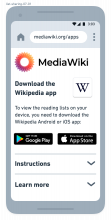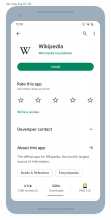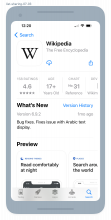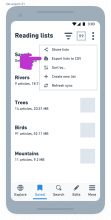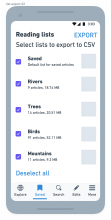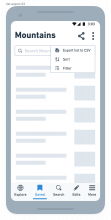Background
The team is currently exploring the creation of a feature that allows users to export all reading lists and share singular reading lists with others. There are several ways to approach exporting, importing, and sharing reading lists. This task is to create low-fi mockups exploring the possibilities so that we can get input from our users and include the pros and cons of each approach.
Approaches to include
- Custom format that allows users to click and easily import without a preview of the list
- File that allows a preview of the list but would require users to open the app and import it
- Concept for someone that does not have the app vs. that will have the app
- Interface for someone sending vs. someone receiving
- Exporting several lists vs. sharing one list
Things to consider
- How might I understand the mockups if I don't speak or read English?
- How might I understand the mockups in an RTL language?
1. User Stories
- As a Wikipedia Android app user and student in Morocco, I want to export my reading lists so that I can use them at the Mohammed V University school library
- As a Wikipedia Android app user in Ghana, I want to share my reading list with a family member in the US that has an iOS device, so they can read the articles I've saved about Accra ahead of their trip home in December.
- As a Wikipedia Android app user organizer in South Asia, I want to share a reading list via Whatsapp after an event, so people that have attended know which articles need contributions
2. Target Quant Regions
Africa (Egypt, Algeria, Morocco, Kenya, DR Congo, Angola, and Ghana) and South Asia (India, Bangladesh, Pakistan, Sri Lanka, and Nepal)
3. Target Qualitative Audience
Usability testing and design research must be conducted with low vision and low bandwidth users. Usability testing and design research must be conducted in target regions and top 5 languages of each region with diversity in age, screen size, low tech and app experience, and with no more than 40% of male participants.
4. Concept (Wireframes ↗)
- The user flow below shows how users share (a) reading list(s) via a messenger app (e.g. Signal).
- The file format for this has to be defined yet (e.g. .wikilist)
The new reading list functionality consists of Share and Export. Design constraints:
- Reading lists are an Android and iOS-only feature (for now)
- We can’t rely on an external service or a landing page. Lists must be files that are shared with other apps.
4.1. Share lists
4.1.1. The receiver has the app installed
| 1. Lists home | 2. Shares multiple | or | 3. Shares one list | 4. Share sheet | 5. Sends message | 6. Receives message | 7. Taps attachment | 8. Import dialog | 9. Import successful | 10. Reads list |
- 1. Lists home + 2. Shares multiple:
- Multiple lists can be shared, e.g. via overflow menu
- 3. Shares one list: One list can be shared, e.g. with the Share icon in the app bar or by long pressing reading list in 1. Lists home
- 4. Share sheet: Is device dependent
- 5. Send message:
- Is service dependent
- Message contains text, a link (see 4.2.) and an attachment (.wikilist). It needs to be localized per language.
- Keep in mind that the current copy: (Check out my reading list with the Wikipedia Android or iOS app: mediawiki.org/WikipediaApps) is a placeholder and needs to be fine-tuned to be effective and work in multiple languages.
- 6. Receives message: is device dependent (notification)
- 7. Taps attachment:
- Is service dependent
- Attachments open directly in the Wikipedia app
- 8. Import dialog:
- From here on, we have complete control over how it's displayed
4.1.2. The receiver does not have the app installed
| 🅰️/🅱️ Testing | ||||
| 1. Taps link | 🅰️ 2. Intermediate page | 🅱️ 3. Google Play | 🅱️ 4. App Store | 5. Taps attachment |
- 1. Taps link: User taps link in the message
- 🅰️/🅱️ Testing: We are going to perform to find out which of the variants performs better (analytics performance criteria yet to be defined by @SNowick_WMF @JTannerWMF)
- Variant 🅰️
- Uses an intermediate web page (e.g. mediawiki.org/wiki/Wikimedia_Apps)
- The site’s exact content is still left to be defined
- Variant 🅱️
- Links directly to Google Play/App Store listing (we do our best for device detection, per @Dmantena’s suggestion in T313740#8138291)
- Variant 🅰️
- 5. Taps attachment:
- For both variants A and B:
- After installing the app, the user needs to navigate back to the service, where the original message (with the attachment) has been received, and tap the attachment
- For both variants A and B:
4.2. Export lists
| 1. Lists home | 2. Exports multiple | or | 3. Exports one list | 4. Direct export | 5. Views file |
- 1. Lists home + 2. Exports multiple:
- Multiple lists can be exported, e.g. via overflow menu
- 3. Export one list: One list can be exported, e.g. with the Export option in the overflow menu or by long pressing a reading list in 1. Lists home
- 4. Direct export:
- Once the export has been triggered in step 3, a system notification is displayed (similar to reading lists sync), and CSV files are stored directly on the device (without a share sheet)
- In addition and very likely: a system notification is triggered that the file’s been stored
